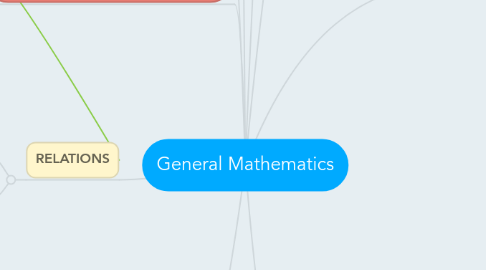
1. RATIONAL FUNCTIONS
1.1. Values
1.1.1. Domain
1.1.1.1. Consists of all real numbers except that make the denominator zero. Equating the denominator to zero will know its restrictions.
1.1.2. Range
1.1.2.1. It usually does not consist of all real numbers and has restrictions depending on the function. It predetermines if there is a horizontal or oblique asymptote.
1.2. Asymptotes
1.2.1. Vertical Asymptote
1.2.1.1. Caused the x values to equate the denominator to zero.
1.2.2. Horizontal/Oblique Asymptote
1.2.2.1. It exists when the range is restricted.
1.3. How to get intercepts?
1.3.1. x - intercept
1.3.1.1. Get the numerator's x's value.
1.3.2. y - intercept
1.3.2.1. Change all x's of the function to zero.
1.4. Example: 5x^2 + 3/x - 9
2. FUNCTIONS
2.1. A relation in which every input is paired with exactly one output.
2.2. Vertical Line Test
2.2.1. A relation is a function if a vertical line is drawn through its graph and passes through only one point.
2.2.2. Also known as "THE PENCIL TEST"
2.3. X and Y Values
2.3.1. DOMAIN - The set of values used for inputs.
2.3.2. RANGE - The set of values used for outputs.
2.3.3. Use "( )" if a solution is not part of it.
2.3.4. Use "[ ]" if a solution is part of it.
2.4. The Use of 2 Functions f and g
2.4.1. Sum
2.4.1.1. (f + g)(x) = f(x) + g(x)
2.4.1.2. Example: f(x) = 5x + 3; g(x) = 6x + 11
2.4.1.2.1. Solution: (f + g)(x) = 5x + 6x + 3 + 11 (f + g)(x) = 11x + 14
2.4.2. Difference
2.4.2.1. (f - g)(x) = f(x) - g(x)
2.4.2.2. Example: f(x) = 5x + 3; g(x) = 6x + 11
2.4.2.2.1. Solution: (f – g)(x) = (5x + 3) – (6x + 11) (f – g)(x) = -x -8
2.4.3. Product
2.4.3.1. (f*g)(x) = f(x)*g(x)
2.4.3.2. Example: f(x) = 5x + 3; g(x) = 6x + 11
2.4.3.2.1. Solution: (f*g)(x) = (5x + 3)(6x + 11) (f*g)(x) = 30x^2 + 55x + 18x + 33 (f*g)(x) = 30x^2 + 73x + 33
2.4.4. Quotient
2.4.4.1. (f/g)(x) = f(x)/g(x)
2.4.4.2. Example: f(x) = 5x + 3; g(x) = 6x + 11
2.4.4.2.1. Solution: (f/g)(x) = 5x + 3/6x + 11
3. All functions are relations but not all relations are functions.
4. RELATIONS
4.1. It is the relationship between sets of information.
4.2. It may be viewed as an ordered pair, mapping design, table, equation, or written in words.
5. LOGIC
5.1. Proposition
5.1.1. Simple Proposition
5.1.2. Compound Proposition
5.1.2.1. Tautology
5.1.2.2. Contradiction
5.1.2.3. Contingency
5.1.2.4. uses...
5.1.2.4.1. Propositional Connections
5.2. Truth Value
5.2.1. Truth Table
5.2.2. Methods of Proof
6. LOGARITHMIC FUNCTIONS
6.1. f(x) = ax , a > 0, a is not equal to 1
6.2. How it functions
6.2.1. f(x) = loga x
6.2.2. example problem: 2x = 16
6.2.2.1. Solution: 2x = 16 2x = 24 X = 4
6.2.3. example problem 2: ln x = 8
6.2.3.1. Solution: eln x = e8 2,980.96 = e8
6.3. Domain
6.3.1. A set of positive real numbers.
6.4. Range
6.4.1. A set of real numbers.
6.5. X - intercept
6.5.1. It is at point (1,0)
6.6. 0 < a < 1
6.6.1. As the value of x increases, the value of y decreases.
6.7. Vertical Asymptote
6.7.1. x = 0 or the y - axis
6.8. Horizontal Asymptote
6.8.1. None
6.9. Laws of exponents
6.9.1. logbm + logbn = logbmn
6.9.2. logbm - logbn = logb m/n
6.9.3. logbm^n = nlogbm
6.9.4. logb
6.9.5. log1b = 0
6.9.6. lognm = logbm/logbn
7. EXPONENTIAL FUNCTIONS
7.1. f(x) = b^x where b > 0 and x is any real number.
7.2. y = 5^x
7.2.1. Higher than 1, the steeper the graph as it rises to the right.
7.3. 0 < b < 1
7.3.1. The lower it is, the steeper its graph as it rises to the left.
7.4. y = a*b^x where a is not equal to 0, b > 0, and b is not equal to 1.
7.4.1. The lower the value, the steeper the slope as it falls to the right.
7.5. Example Problem: 3^2x - 5 = 3^x + 3
7.5.1. Solution: 2x - 5 = x + 3 x = 5 + 3 x = 8
8. BUSINESS MATHEMATICS
8.1. Centers around...
8.1.1. MONEY
8.1.1.1. earns...
8.1.1.1.1. Simple Interest
8.1.1.1.2. Compound Interest
8.1.1.2. Maturity Value
8.1.1.3. Present Value
8.1.1.4. invested in...
8.1.1.4.1. Annuities
9. INVERSE FUNCTIONS
9.1. Definition
9.1.1. A function that shares an inverse relation where the domain become the range's values while the range become the domain's values.
9.1.2. The inverse relation is not a function.
9.2. One - to - one function
9.2.1. A function where each value in its domain is assigned a different value in range.
9.2.2. Horizontal Line Test
9.2.2.1. a function is one - to - one if and only if no horizontal line intersects the graph of y = f(x) in more than one point.
9.3. Example: x = 5x
9.3.1. Solution: y = 5x x = 5y y = x/5
